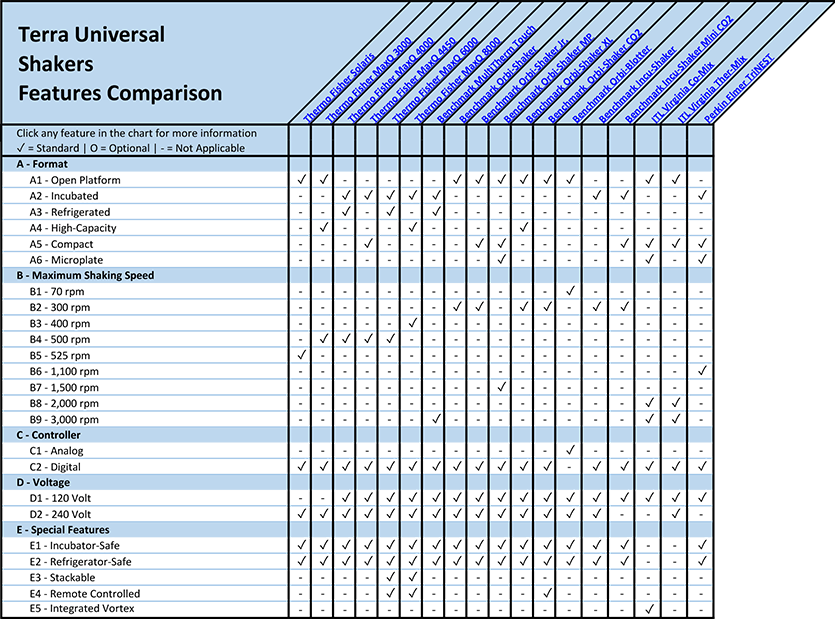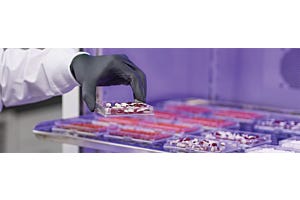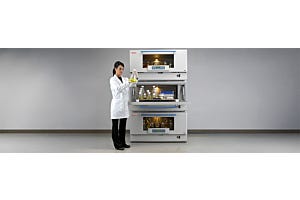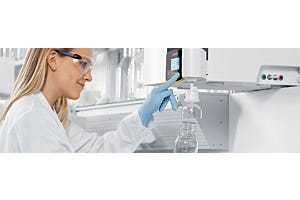
Overview: Laboratory Shakers Defined
What is a Lab Shaker?
Laboratory shakers rotate in an orbital, or reciprocating, motion to ensure thorough mixing of liquid samples and reagents.
What Are Lab Shakers Used For?
Lab shakers, or mixers, are commonly used in a wide variety of applications, including DNA extraction and isolation, gel staining, Western and Southern Blots, reagent preparation, sample agitation, and cell culture.
Lab Shaker Design & Features
Typical lab shakers include a platform designed to oscillate on a horizontal plane, clamps to hold flasks, beakers, tube racks, basins, gel trays and microplates, and a digital or analog controller. The dimensions of the platform and the quantity of compatible clamps determine the number of samples processed during a single run.
Thermo Fisher Lab Shaker Systems
Thermo Fisher’s MaxQ 6000 high-volume shakers include platforms that stack vertically to allow more samples to be mixed during a single operation. Simple analog controllers include a timer, on/off switch, and speed dial. In contrast, sophisticated digital controllers include password protection, user-programmable protocols, excess speed alarms, and e-signature systems for 21 CFR Part 11 compliance.
Lab Shaker Movement and Motion
Lab shakers and mixers are designed to oscillate in a variety of different motions: orbital, reciprocating, rocking, and vortex. Conventional orbital shakers move in a 2-dimensional motion, along the horizontal plane, across the x- and z-axes. This gentle mixing motion is ideal for applications such as bacterial cell culture, reagent prep, and dissolution studies.
What is a Reciprocating Shaker?
Reciprocating shakers move in a 3-dimensions motion, both horizontally and vertically, along the x-, y- and z-axes. The reciprocating motion is optimal for thorough, homogenous mixing of low-volume samples, like PCR and DNA sequencing.
What is a Lab Rocker?
Lab rockers, or tube rollers, maintain an orbital motion, but the platform is tilted to a fixed, or adjustable, angle. Given the angle of the platform, rockers must maintain low mixing speeds (under 50 rpm) to prevent the spillage of samples or reagents. Common applications for rockers, or tube rollers, include gel staining, Western Blotting, tissue culture, and reagent thawing in a water bath.
What is a Vortex Mixer?
Vortex mixers maintain a circular, rather than an orbital motion, for mixing single samples. Unlike orbital shakers or rockers, vortex mixers include a pad, rather than a platform. As the sample tube contacts the pad, the circular motion is transferred to the liquid, forming a visible vortex. Vortex mixers are optimal for applications such as cell suspension and sample thawing.
What are Lab Shakers and Mixers Used For?
Lab shakers and mixers are commonly used in many industries, including genomics, proteomics, medical microbiology, clinical diagnostics, molecular biology, mammalian and bacterial cell culture, blood banking, and medical outpatient clinics.
A - Lab Shaker and Mixer Format
(back to chart)
A1 - Open Platform Lab Shakers
Traditional orbital shakers, like Thermo Fisher’s Solaris line, feature open platforms, commonly made of stainless steel, for easy access to load and unload samples and reagents. Ideal for busy, high-throughput labs or shared-use spaces, open-air shakers allow researchers to quickly mix samples without the hassle of opening and closing sample covers. However, open-air shakers leave samples and reagents exposed to possible cross-contamination, so samples must be mixed in screw-cap or pop-top tubes and flasks must be covered in Paraffin. As open-air shakers don’t include a sample cover, they are compatible with taller vessels, such as graduated cylinders, reagent troughs, and 4L flasks.
A2 - Incubated Lab Shakers
Specific shaker models, such as Thermo Fisher’s MaxQ 4000 and MaxQ 4450, include integrated incubators for mammalian and bacterial cell culture sampling.
Incubated shakers commonly include an orbital-shaking platform enclosed in an insulated cover, driven by an onboard controller capable of adjusting temperature and mixing speed.
Incubated shakers, such as Benchmark Scientific’s Incu-Shaker, feature a heavy cover that mitigates cross-contamination more effectively than open-air shakers. However, the sample platform is more restricted, making incubated shakers incompatible with taller sample vessels.
A3 - Refrigerated Lab Shakers
Refrigerated shakers, such as Thermo’s MaxQ 6000, include an enclosed platform and on-board controller capable of adjusting the temperature in the sampling area from 37°C down to -15°C. Ideal for temperature-sensitive samples and reagents, refrigerated shakers include over-temperature alarms and safety kill switches connected to the sample cover. As high shaking speeds impact the temperature set point maintained within the sampling area, refrigerated or incubated shakers commonly don’t exceed speeds of 500 rpm.
A4 - High Capacity Shakers
High-capacity shakers, such as Benchmark Scientific’s Orbi-Shaker XL and Thermo Fisher’s MaxQ 3000, feature larger platforms (up to 36” wide x 24” deep) to house larger quantities of samples or larger sample vessels. Ideal for high-throughput labs, high-capacity shakers accommodate up to 25 x 250 ml flasks or 8 microplates during a single run. As high-capacity shakers feature a heavy, bulky platform, they cannot maintain shaking speeds above 500 rpm. Common applications for large-capacity models include sequencing labs, high-throughput screening (HTS), and core facilities.
A5 - Compact Shakers
Compact shakers, such as ITL Virginia Co-Mix and Benchmark Scientific’s Orbi-Shaker Jr., feature a small footprint, with a platform size under 10” wide x 8” deep, for crowded labs with precious open benchtop space. Ideal for teaching labs or academic research, economical compact shakers rarely include temperature control, access security, or high-speed mixing options. However, compact shakers are often extremely durable and low-maintenance, boasting a longer lifespan than their sophisticated counterparts.
A6 - Microplate Shakers for PCR | DNA
Benchmark Scientific’s Orbi-Shaker MP microplate shakers include platforms designed to accommodate deep-well, skirted, and semi-skirted PCR plates (in 96-well and 384-well formats). Microplates often contain smaller sample volumes (under 10 ul), so microplate shakers are designed to maintain high shaking speeds (up to 1,500 rpm) to ensure sample homogeneity.
Featuring smaller footprints than larger orbital shakers, microplate-compatible models are designed to operate in cold rooms, incubators, test chambers or walk-in refrigerators.
What is a Microplate Shaker Used For?
Common applications for microplate shakers include DNA sequencing labs, forensics, whole-genome sequencing centers, environmental research, genetic testing labs, and clinical diagnostics.
B - Maximum Shaking Speed
(back to chart)
Laboratory shakers are designed to maintain fixed or adjustable shaking speeds to accommodate different sample types and protocols. Rockers, rotators, and blotters, like Benchmark Scientific’s Orbi-Blotter, maintain low shaking speeds (down to 70 rpm) for gel staining, Western and Southern Blotting, and reagent thawing.
Conventional shakers, like Thermo Fisher’s MaxQ 4000 or MaxQ 4450, maintain shaking speeds between 300 rpm and 500 rpm for applications such as bacterial cell culture, PCR prep, and chemical synthesis.
High-speed shakers maintain shaking speeds between 1,000 rpm and 3,000 rpm for ELISA sample prep, bacterial protocols, and enzymatic reactions.
C - Lab Shaker and Mixer Controllers
(back to chart)
C1 - Analog Lab Shakers and Mixers
Benchmark Scientific’s Orbi-Blotter lab shakers feature analog controllers with on/off switches, speed control dials, and touch-start/manual-start toggles.
C2 - Lab Shaker and Mixer Voltage
Digital lab shakers and mixers, like Benchmark Scientific’s Incu-Shaker, feature digital controllers with speed adjustment, temperature control, run timers, password protections, data exports, and stored user-defined programs.
D - Lab Shaker and Mixer Voltage
(back to chart)
120-volt connections are suitable for standard laboratory power outlets in the United States, Canada, Mexico, and South America. 240-volt connections, common in Mainland Europe and throughout Asia, require less current (amperage) and smaller conductors than equipment designed to operate at 120-volt.
E - Lab Shaker Special Features
(back to chart)
E1 - Incubator-Safe Orbital Shakers
Thermo Fisher’s Solaris models are designed to operate in incubation conditions (37°C) for bacterial cell culture and human tissue culture studies.
E2 - Refrigerator-Safe
Thermo Fisher’s MaxQ Series, designed to operate at 4°C in cold rooms or walk-in refrigerators, are ideal for processing temperature-sensitive samples, certain shakers, like, are.
E3 - Stackable Shakers
High-volume shakers, like Thermo Fisher’s MaxQ 6000, include platforms that stack vertically to allow a larger quantity of samples to be mixed during a single operation.
E4 - Remote-Controlled Lab Mixers & Shakers
Certain models, like Thermo Fisher’s MaxQ 8000, include optional remote control and remote alarm systems with BMS integration, secure user access, password protection, and real-time monitoring of sample conditions
E5 - Integrated Vortex Mixers
ITL Virginia Co-Mix Shakers include an integrated vortex mixer installed adjacent to the shaking platform, allowing for simultaneous vortex mixing and orbital shaking of samples and reagents.
Where Can I Buy Laboratory Rockers and Mixers Online?
(back to chart)
Laboratory-Equipment.com is a specialty division of Terra Universal. For nearly 40 years, Terra Universal has served semiconductor, aerospace, life science, pharmaceutical, biotechnology, and medical device markets. Customers appreciate a worldwide network of reps, factory-direct support, and ready-to-ship items available from Terra's manufacturing and warehouse facilities in Fullerton, California.
Shop online to compare pricing, features, and selection for a wide variety of lab mixing equipment including rockers, shakers, and stirrers. Browse a curated list of products for applications including general laboratory, research, PCR, DNA/RNA techniques, ELISA, protein analysis, and cell culture.















